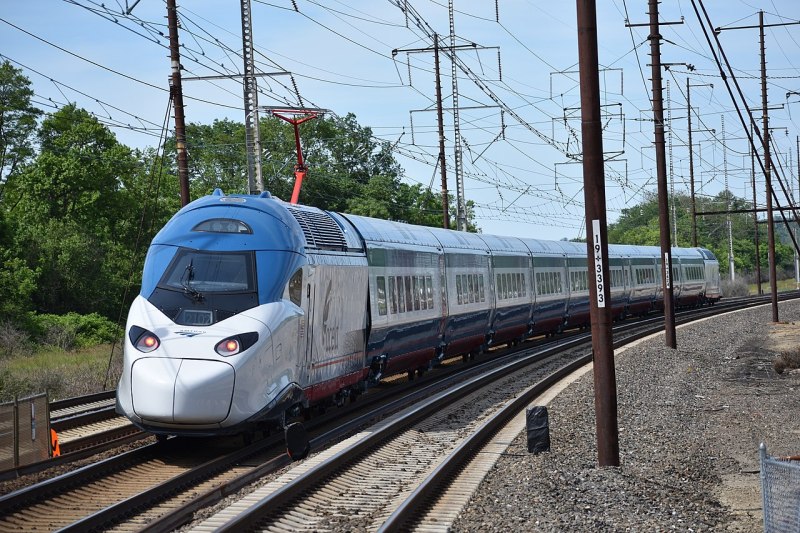Note: GJEL Accident Attorneys regularly sponsors coverage on Streetsblog San Francisco and Streetsblog California. Unless noted in the story, GJEL Accident Attorneys is not consulted for the content or editorial direction of the sponsored content.
With the passage of a $1.2-trillion surface transportation reauthorization bill, Amtrak Joe Biden has come through on his promise to fund trains throughout the nation. From a White House statement:
The legislation positions Amtrak and rail to play a central role in our transportation and economic future. This is the largest investment in passenger rail since the creation of Amtrak 50 years ago. The legislation invests $66 billion in rail to eliminate the Amtrak maintenance backlog, modernize the Northeast Corridor, and bring world-class rail service to areas outside the northeast and mid-Atlantic.
“We haven’t seen this level of investment in infrastructure in decades in the U.S. There are several areas where California programs, including ours, can be competitive," wrote the California High-Speed Rail Authority's Michele Boudreau. "We look forward to competing as we work to advance the nation’s first high-speed rail program.”
The breakdowns are a bit complex, but California's high-speed rail project will be in a good position to compete for $36 billion in federal grants over the next five years, explained the national Rail Passenger Association's Sean Jeans-Gail. Given the way the U.S. has neglected its rail system for so many decades, this is still only "a down payment on a much bigger system." But the bill that just passed with significant Republican support is only the first half of the infrastructure package. There's another package winding its way through the budget reconciliation process. Those additional funds, in addition to state matching funds, could be key in getting California's project finished.
“President Biden understands the need to build a climate-resilient future, and the infrastructure package passed by Congress builds on California’s unprecedented investments to maintain and modernize the state,” said Governor Newsom in a prepared statement. “This historic infrastructure package stands to accelerate investments in our clean transportation infrastructure, help mitigate some of the worst impacts of climate change and accelerate new projects that will create thousands of jobs.”
It's important to note, however, that the infrastructure bill that passed is also a disappointment in many respects. As Streetsblog USA points out, highways and airports continue to dominate, again getting massive government funding.
For some perspective on California's ability to compete for federal high-speed rail funds: in 2009, California's project was awarded $3.5 billion from an $8 billion federal high-speed rail package. And that was when the project was still just a bunch of blueprints. Now, with construction ongoing throughout the Central Valley and detailed planning finished throughout the state, the route towards funding high-speed links all the way to Los Angeles and directly to San Francisco is coming into view.
But federal budget items generally require state matching. That's why the biggest remaining challenge to completing the project is the Democrat majority state legislature. Assemblymembers Anthony Rendon and Laura Friedman, ironically, don't seem to want the project to ever reach their own constituents in Los Angeles. Currently, they are holding up over $4 billion in voter-approved bond money for the project, which was allocated by Governor Newsom but rejected by these legislators. This money is intended to allow operations to begin on the first segment, which would run from the Bay Area to Merced on conventional rail, and then continue to Bakersfield at over 200 mph, while direct connections to Los Angeles and San Francisco are completed.
Meanwhile, Rendon and Friedman, who is chair of the Assembly Transportation Committee, reported in from Scotland where they are attending the global climate summit.
We’re off and ready to work at #COP26. As a National and world leader on climate policy, we’re here to make sure CA’s voice is heard.
— Laura Friedman (@LauraFriedmanCA) November 8, 2021
@Rendon63rd @LuzRivas @ib2_real pic.twitter.com/b0JGlI8w2M
As several people pointed out in replies to Rendon and Friedman's post, their climate reputation went up in a puff of carcinogenic diesel smoke when they came out against electrifying high-speed rail. Streetsblog agrees with "Entitled Cyclist" that popping up at a climate summit doesn't begin to make up for that.
One hopes that when state budget negotiations begin again in January, the pressure will mount on Friedman and Rendon to make good on their spoken commitment to fighting climate change and release the remainder of the voter-approved high-speed rail funds so the state's most important transportation project can be electrified and finished. That, in turn, will put the state in an excellent position to compete for federal matching funds and, at long last, finish the train.







